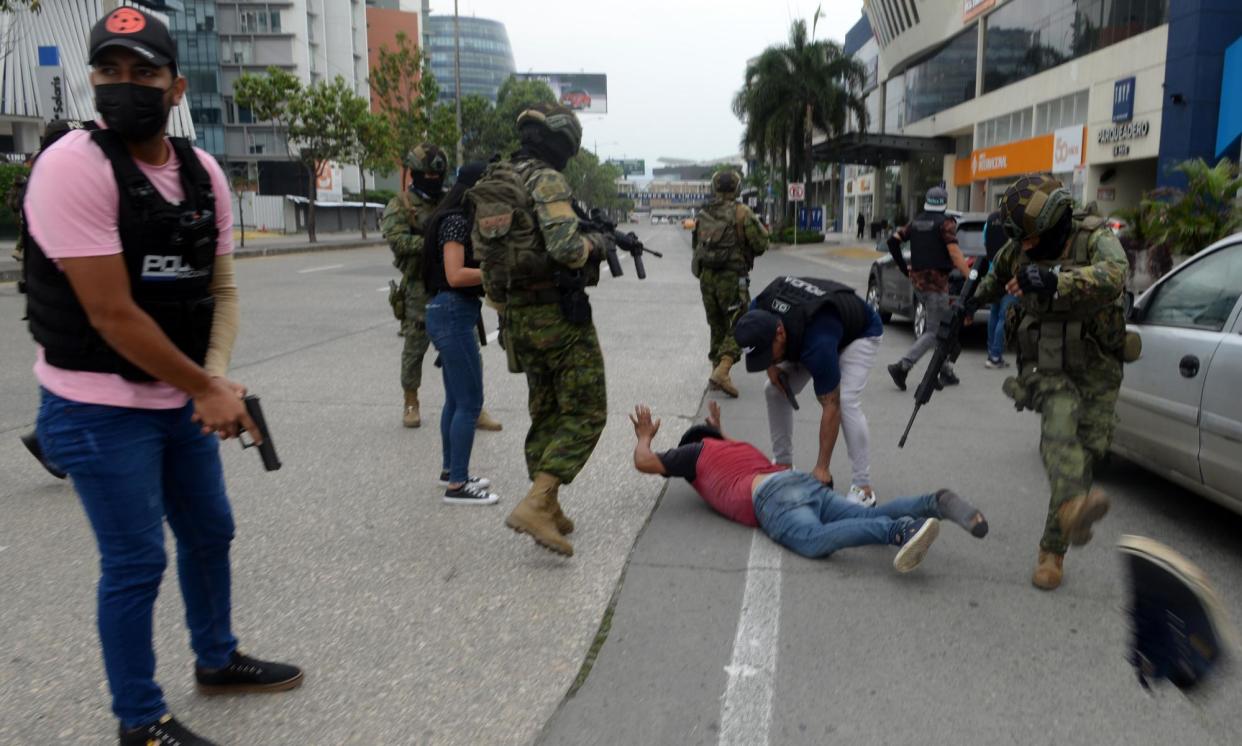Armed gangs and prison breaks: how Ecuador was plunged into chaos and bloodshed

Few Ecuadoreans were prepared for just how swiftly and steeply the security situation in their country could plummet. Murder and violence linked to drug trafficking has soared, as the country has become one of the most dangerous in Latin America.
Until just a few years ago, Ecuador was a corner of relative peace sandwiched between the world’s two biggest cocaine producers, Colombia and Peru, which have recently seen their own violent internal conflicts between security forces and nominally leftist rebels linked to the lucrative drugs trade.
Facing its own surge in violence, Ecuador’s young president, Daniel Noboa, has declared a state of “internal armed conflict”, designating 20 drug trafficking gangs as terrorist groups and authorising Ecuador’s military to “neutralise” the crime factions “within the bounds of international humanitarian law”.
That announcement came as Ecuador was plunged into chaos and bloodshed after the country’s most notorious gang leader and druglord, Adolfo Macías, alias Fito, escaped from prison on Sunday. Noboa’s subsequent declaration of a state of emergency prompted criminals to unleash a wave of attacks inside and outside prisons which have seen police and prison guards murdered and a TV station invaded by armed gangsters during a live broadcast.
Ecuadoreans are terrified. Not so long ago Ecuador was better known for its volcanoes, its rich biodiversity and even as a retirement retreat for US senior citizens enjoying the temperate climate and lower cost of living on their pensions.
“We’ve never seen this before,” said Fernando Carrión, a security expert with the Latin American Social Sciences Institute in Quito. “We always defined ourselves as an island of peace. But we saw this coming,” he added.
The rate of violent deaths in the South American country in 2017 was five per 100,000 inhabitants, Carrión says. It is now 46, which “makes 2023 the most violent year in Ecuador’s history”, he said. According to police records, 2023 saw at least 7,592 violent deaths, compared with 4,426 in a year earlier.
The latest explosion of violence is linked to the jailbreak not just of Macías but also of another gang leader, Fabricio Colón, who escaped prison during disturbances on Monday night. The prosecutor’s office has linked Colón, a leader of the Los Lobos gang, to the assassination of the presidential candidate Fernando Villavicencio last year and death threats against the attorney general, Diana Salazar.
Never before have organised crime’s tentacles reached so far into the corridors of power, said Carrión, and now several gangs are rebelling against the new president’s tough approach as he attempts to shake up their control of the prisons, pledging to militarise jails, lengthen sentences and isolate powerful kingpins like those who just escaped.
Last week, Noboa pledged to follow the lead of El Salvador’s president, Nayib Bukele, and construct two maximum security prisons using the same company and design as those built by the popular leader.
Trapped between economic hardship, extortion rackets and the very real risk of being the victim of violent crime, many Ecuadoreans have chosen to flee. Tens of thousands have risked it all, heading north via the perilous Darién Gap between Colombia and Panama, becoming the second largest nationality after Venezuelans to make the journey, according to Panama’s migration office.
It is Ecuador’s globalized economy – with access to markets in Asia and Europe but poor security controls in its ports – that has made it a hub for cocaine trafficking around the world, explained Renato Rivera of the Ecuadorian Observatory on Organised Crime. Ecuador exports around 1m containers a year, of which 75% are bananas, according to General Pablo Ramírez, the former police anti-narcotics director and the trade provides the perfect cover for drug shipments.
Much of Ecuador’s rising violence has been driven by competition between an expanding cluster of local crime gangs, who learned their brutally violent scare tactics from their backers, the rival Mexican drug cartels Sinaloa and Jalisco New Generation.
The gangs also do business with Balkan traffickers, who control the lucrative European market that has displaced the United States as the main destination for cocaine. The rival factions have learned urban guerrilla tactics from disbanded Colombian guerrilla groups, who, according to security experts, have branched out their drugs and crime businesses into neighbouring countries since the 2016 Colombia peace agreement.
Now, however, those bloodthirsty tactics are being turned against a common enemy – the Ecuadorian state.


